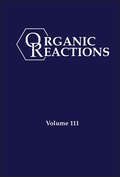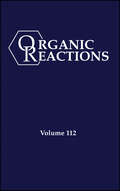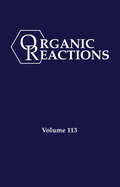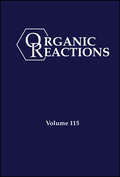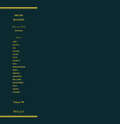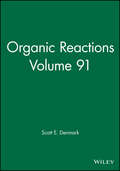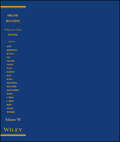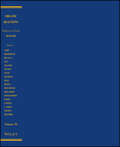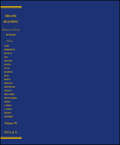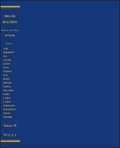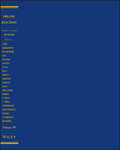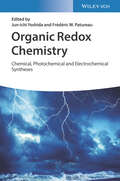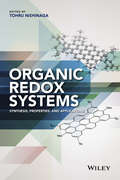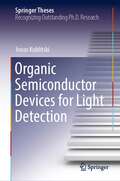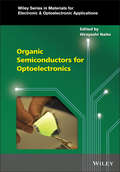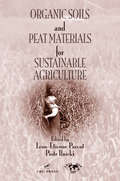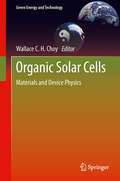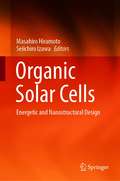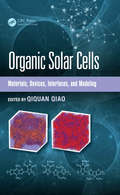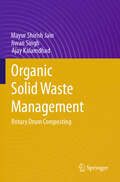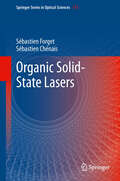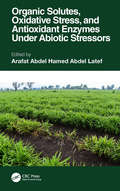- Table View
- List View
Organic Reactions, Volume 111 (Organic Reactions)
by P. Andrew EvansThe 111th volume in this series for organic chemists in academia and industry presents critical discussions of widely used organic reactions or particular steps of a reaction. The material is treated from a preparative viewpoint, with emphasis on limitations, interfering influences, effects of structure and the selection of experimental techniques. The work includes tables that contain all possible examples of the reaction under consideration. Detailed procedures illustrate the significant modifications of each method. Volume contents: RING-OPENING REACTIONS OF EPOXIDES WITH TITANIUM(III) REAGENTS T. V. (Babu) RajanBabu, William A. Nugent, and Sandipan Halder REDUCTIVE CYCLIZATION OF 2-NITRO- AND β-NITROSTYRENES, 2-NITROBIPHENYLS, AND 1-NITRO-1,3-DIENES TO INDOLES, CARBAZOLES, AND PYRROLES Björn C. G. Söderberg and William F. Berkowitz
Organic Reactions, Volume 112, Parts A and B (Organic Reactions)
by P. Andrew EvansA carefully curated review of the scientific literature, Volume 112 of Organic Reactions commemorates the 50th anniversary of the Ugi reaction. It explores the practical and theoretical aspects of one of the most widely used reactions in organic chemistry, focusing on the main Ugi reaction as well as on its many variants. This volume is published in two parts, A and B. Launched in 1942, the Organic Reactions series today is a leading secondary- and tertiary-level source for organic chemists across the world.
Organic Reactions, Volume 113 (Organic Reactions)
by P. Andrew EvansA carefully curated review of the scientific literature, Volume 113 of Organic Reactions presents critical discussions of widely used organic reactions or particular steps of a reaction. The material is treated from a preparative viewpoint, with emphasis on limitations, interfering influences, effects of structure and the selection of experimental techniques. The work includes tables that contain all possible examples of the reaction under consideration. Detailed procedures illustrate the significant modifications of each method. Launched in 1942, the Organic Reactions series today is a leading secondary- and tertiary-level source for organic chemists across the world.
Organic Reactions, Volume 114 (Organic Reactions)
by P. Andrew EvansA carefully curated review of the scientific literature, Volume 114 of Organic Reactions presents critical discussions of widely used organic reactions or particular steps of a reaction. The material is treated from a preparative viewpoint, with emphasis on limitations, interfering influences, effects of structure and the selection of experimental techniques. The work includes tables that contain all possible examples of the reaction under consideration. Detailed procedures illustrate the significant modifications of each method. Launched in 1942, the Organic Reactions series today is a leading secondary- and tertiary-level source for organic chemists across the world.
Organic Reactions, Volume 115 (Organic Reactions)
by P. Andrew EvansA carefully curated review of the scientific literature, Volume 115 of Organic Reactions presents critical discussions of widely used organic reactions or particular steps of a reaction. The material is treated from a preparative viewpoint, with emphasis on limitations, interfering influences, effects of structure and the selection of experimental techniques. The work includes tables that contain all possible examples of the reaction under consideration. Detailed procedures illustrate the significant modifications of each method. Launched in 1942, the Organic Reactions series today is a leading secondary- and tertiary-level source for organic chemists across the world.
Organic Reactions, Volume 90 (Organic Reactions #97)
by Scott E. DenmarkThe latest volume in this series for organic chemists in industry presents critical discussions of widely used organic reactions or particular phases of a reaction. The material is treated from a preparative viewpoint, with emphasis on limitations, interfering influences, effects of structure and the selection of experimental techniques. The work includes tables that contain all possible examples of the reaction under consideration. Detailed procedures illustrate the significant modifications of each method.
Organic Reactions, Volume 91 (Organic Reactions #97)
by Scott E. DenmarkThe latest volume in this series for organic chemists in industry presents critical discussions of widely used organic reactions or particular phases of a reaction. The material is treated from a preparative viewpoint, with emphasis on limitations, interfering influences, effects of structure and the selection of experimental techniques. The work includes tables that contain all possible examples of the reaction under consideration. Detailed procedures illustrate the significant modifications of each method.
Organic Reactions, Volume 92 (Organic Reactions #97)
by Scott E. DenmarkThe latest volume in this series for organic chemists in industry presents critical discussions of widely used organic reactions or particular phases of a reaction. The material is treated from a preparative viewpoint, with emphasis on limitations, interfering influences, effects of structure and the selection of experimental techniques. The work includes tables that contain all possible examples of the reaction under consideration. Detailed procedures illustrate the significant modifications of each method.
Organic Reactions, Volume 93 (Organic Reactions #97)
by Scott E. DenmarkThe latest volume in this series for organic chemists in industry presents critical discussions of widely used organic reactions or particular phases of a reaction. The material is treated from a preparative viewpoint, with emphasis on limitations, interfering influences, effects of structure and the selection of experimental techniques. The work includes tables that contain all possible examples of the reaction under consideration. Detailed procedures illustrate the significant modifications of each method.
Organic Reactions, Volume 94 (Organic Reactions #97)
by Scott E. DenmarkThe 94th volume in this series for organic chemists in industry presents critical discussions of widely used organic reactions or particular phases of a reaction. The material is treated from a preparative viewpoint, with emphasis on limitations, interfering influences, effects of structure and the selection of experimental techniques. The work includes tables that contain all possible examples of the reaction under consideration. Detailed procedures illustrate the significant modifications of each method.
Organic Reactions, Volume 95 (Organic Reactions #97)
by Scott E. DenmarkThe 95th volume in this series for organic chemists in industry presents critical discussions of widely used organic reactions or particular phases of a reaction. The material is treated from a preparative viewpoint, with emphasis on limitations, interfering influences, effects of structure and the selection of experimental techniques. The work includes tables that contain all possible examples of the reaction under consideration. Detailed procedures illustrate the significant modifications of each method.
Organic Reactions, Volume 98 (Organic Reactions Ser. #97)
by Scott E. DenmarkThe 98th volume in this series for organic chemists in academia and industry presents critical discussions of widely used organic reactions or particular phases of a reaction. The material is treated from a preparative viewpoint, with emphasis on limitations, interfering influences, effects of structure and the selection of experimental techniques. The work includes tables that contain all possible examples of the reaction under consideration. Detailed procedures illustrate the significant modifications of each method.
Organic Reactions, Volume 99 (Organic Reactions Ser. #97)
by Scott E. DenmarkThe 99th volume in this series for organic chemists in academia and industry presents critical discussions of widely used organic reactions or particular phases of a reaction. The material is treated from a preparative viewpoint, with emphasis on limitations, interfering influences, effects of structure and the selection of experimental techniques. The work includes tables that contain all possible examples of the reaction under consideration. Detailed procedures illustrate the significant modifications of each method
Organic Redox Chemistry: Chemical, Photochemical and Electrochemical Syntheses
by Frederic W. PatureauExplore the most recent advancements and synthesis applications in redox chemistry With a large number of applications in industrial settings, redox chemistry has emerged as a crucial research topic that covers many aspects of different methodologies in synthesis. In Organic Redox Chemistry: Chemical, Photochemical and Electrochemical Syntheses, accomplished researchers and editors Dr. Frederic W. Patureau and the late Dr. Jun-Ichi Yoshida deliver an insightful exploration of this rapidly developing topic. Rather than divide its material into ionic, radical, and metal- or organocatalyzed transformations, this book highlights electron transfer processes in synthesis by using different ways to initiate them, allowing for a unique and different perspective in synthetic chemistry. Covering a wide array of the important and recent developments in the field, Organic Redox Chemistry compares chemical, photochemical, and electrochemical methods. In addition to covering all significant aspects of organic redox chemistry, the book also includes coverage of: Thorough introductions to both chemical and electrochemical oxidative C-C bond formation Explorations of the fundamentals of photochemical redox reactions and C-H bond functionalization with chemical oxidants Practical discussions of electrochemical reductive transformations and redox-mediated polymer synthesis, as well as chemical paired transformations A concise treatment of photochemical paired transformations and paired electrolysis Perfect for organic, catalytic, pharmaceutical, and medicinal chemists, Organic Redox Chemistry will also earn a place in the libraries of photochemists and electrochemists seeking a one-stop resource that compares the chemical, photochemical, and electrochemical methods for redox chemistry.
Organic Redox Systems: Synthesis, Properties, and Applications
by Tohru NishinagaProviding a thorough overview of leading research from internationally-recognized contributing authors, this book describes methods for the preparation and application of redox systems for organic electronic materials like transistors, photovoltaics, and batteries. • Covers bond formation and cleavage, supramolecular systems, molecular design, and synthesis and properties• Addresses preparative methods, unique structural features, physical properties, and material applications of redox active p-conjugated systems• Offers a useful guide for both academic and industrial chemists involved with organic electronic materials• Focuses on the transition-metal-free redox systems composed of organic and organo main group compounds
Organic Semiconductor Devices for Light Detection (Springer Theses)
by Jonas KublitskiIn recent decades, the way human beings interact with technology has been significantly transformed. In our daily life, ever fewer manually controlled devices are used, giving way to automatized houses, cars, and devices. A significant part of this technological revolution relies on signal detection and evaluation, placing detectors as core devices for further technological developments. This book introduces a versatile contribution to achieving light sensing: Organic Semiconductor Devices for Light Detection. The text is organized to guide the reader through the main concepts of light detection, followed by a introduction to the semiconducting properties of organic molecular solids. The sources of non-idealities in organic photodetectors are presented in chapter 5, and a new device concept, which aims to overcome some of the limitation discussed in the previous chapters, is demonstrated. Finally, an overview of the field is given with a selection of open points for future investigation.
Organic Semiconductors for Optoelectronics (Wiley Series in Materials for Electronic & Optoelectronic Applications)
by Hiroyoshi NaitoComprehensive coverage of organic electronics, including fundamental theory, basic properties, characterization methods, device physics, and future trends Organic semiconductor materials have vast commercial potential for a wide range of applications, from self-emitting OLED displays and solid-state lighting to plastic electronics and organic solar cells. As research in organic optoelectronic devices continues to expand at an unprecedented rate, organic semiconductors are being applied to flexible displays, biosensors, and other cost-effective green devices in ways not possible with conventional inorganic semiconductors. Organic Semiconductors for Optoelectronics is an up-to-date review of the both the fundamental theory and latest research and development advances in organic semiconductors. Featuring contributions from an international team of experts, this comprehensive volume covers basic properties of organic semiconductors, characterization techniques, device physics, and future trends in organic device development. Detailed chapters provide key information on the device physics of organic field-effect transistors, organic light-emitting diodes, organic solar cells, organic photosensors, and more. This authoritative resource: Provides a clear understanding of the optoelectronic properties of organic semiconductors and their influence to overall device performance Explains the theories behind relevant mechanisms in organic semiconducting materials and in organic devices Discusses current and future trends and challenges in the development of organic optoelectronic devices Reviews electronic properties, device mechanisms, and characterization techniques of organic semiconducting materials Covers theoretical concepts of optical properties of organic semiconductors including fluorescent, phosphorescent, and thermally-assisted delayed fluorescent emitters An important new addition to the Wiley Series in Materials for Electronic & Optoelectronic Applications, Organic Semiconductors for Optoelectronics bridges the gap between advanced books and undergraduate textbooks on semiconductor physics and solid-state physics. It is essential reading for academic researchers, graduate students, and industry professionals involved in organic electronics, materials science, thin film devices, and optoelectronics research and development.
Organic Soils and Peat Materials for Sustainable Agriculture
by Leon-Etienne Parent Piotr IlnickiWhile organic soils have the potential to contribute greatly to agricultural production, the irreversible processes that occur from draining organic soils need to be managed with caution. The wise use of peatlands must include the avoidance of unacceptable ecological effects on the contiguous and global environment. Organic Soils and Peat Materials
Organic Solar Cells
by Wallace C.H. ChoyOrganic solar cells have emerged as new promising photovoltaic devices due to their potential applications in large area, printable and flexible solar panels. Organic Solar Cells: Materials and Device Physics offers an updated review on the topics covering the synthesis, properties and applications of new materials for various critical roles in devices from electrodes, interface and carrier transport materials, to the active layer composed of donors and acceptors. Addressing the important device physics issues of carrier and exciton dynamics and interface stability and novel light trapping structures, the potential for hybrid organic solar cells to provide high efficiency solar cells is examined and discussed in detail. Specific chapters covers key areas including: Latest research and designs for highly effective polymer donors/acceptors and interface materials Synthesis and application of highly transparent and conductive graphene Exciton and charge dynamics for in-depth understanding of the mechanism underlying organic solar cells. New potentials and emerging functionalities of plasmonic effects in OSCs Interface Degradation Mechanisms in organic photovoltaics improving the entire device lifetime Device architecture and operation mechanism of organic/ inorganic hybrid solar cells for next generation of high performance photovoltaics This reference can be practically and theoretically applied by senior undergraduates, postgraduates, engineers, scientists, researchers, and project managers with some fundamental knowledge in organic and inorganic semiconductor materials or devices.
Organic Solar Cells: Device Physics, Processing, Degradation, and Prevention
by Pankaj KumarThis book contains detailed information on the types, structure, fabrication, and characterization of organic solar cells (OSCs). It discusses processes to improve efficiencies and the prevention of degradation in OSCs. It compares the cost-effectiveness of OSCs to those based on crystalline silicon and discusses ways to make OSCs more economical. This book provides a practical guide for the fabrication, processing, and characterization of OSCs and paves the way for further development in OSC technology.
Organic Solar Cells: Energetic and Nanostructural Design
by Masahiro Hiramoto Seiichiro IzawaThis book focuses on the essential scientific ideas and breakthroughs in the last three decades for organic solar cells that have realized practical applications. The motivation for publishing this book is to explain how those essential ideas have arisen and to provide a foundation for future progress by target readers—students, novices in the field, and scientists with expertise. The main topics covered in the book include the fundamental principles and history of organic solar cells, blended junction, nanostructure control, photocurrent generation, photovoltage generation, doping, practical organic solar cells, and possible ideas for the future. The editors enthusiastically anticipate the vigorous development of the field of organic solar cells by young scientists of the next generation.
Organic Solar Cells: Materials, Devices, Interfaces, and Modeling (Devices, Circuits, and Systems #38)
by Qiquan QiaoCurrent energy consumption mainly depends on fossil fuels that are limited and can cause environmental issues such as greenhouse gas emissions and global warming. These factors have stimulated the search for alternate, clean, and renewable energy sources. Solar cells are some of the most promising clean and readily available energy sources. Plus, the successful utilization of solar energy can help reduce the dependence on fossil fuels. Recently, organic solar cells have gained extensive attention as a next-generation photovoltaic technology due to their light weight, mechanical flexibility, and solution-based cost-effective processing. Organic Solar Cells: Materials, Devices, Interfaces, and Modeling provides an in-depth understanding of the current state of the art of organic solar cell technology. Encompassing the full spectrum of organic solar cell materials, modeling and simulation, and device physics and engineering, this comprehensive text: Discusses active layer, interfacial, and transparent electrode materials Explains how to relate synthesis parameters to morphology of the photoactive layer using molecular dynamics simulations Offers insight into coupling morphology and interfaces with charge transport in organic solar cells Explores photoexcited carrier dynamics, defect states, interface engineering, and nanophase separation Covers inorganic–organic hybrids, tandem structure, and graphene-based polymer solar cells Organic Solar Cells: Materials, Devices, Interfaces, and Modeling makes an ideal reference for scientists and engineers as well as researchers and students entering the field from broad disciplines including chemistry, material science and engineering, physics, nanotechnology, nanoscience, and electrical engineering.
Organic Solid Waste Management: Rotary Drum Composting
by Jiwan Singh Ajay Kalamdhad Mayur Shirish JainThis book offers a comprehensive examination of the rotary drum composter as an effective solution for managing organic waste. With a focus on decentralized systems, it emphasizes the benefits of on-site composting to reduce waste transportation's environmental and economic costs. The book explores the underlying science and engineering principles behind the rotary drum composter, highlighting its ability to create high-quality compost in a controlled environment. Various studies are presented, detailing its successful application in handling municipal solid waste, sewage sludge, agricultural residues, and weeds. Additionally, the text delves into key factors such as temperature control, aeration, and microbial dynamics that influence the composting process. Real-world case studies from premier Indian institutions, including the IITs and NITs, illustrate rotary drum composters' technological advancements and operational efficiencies. The book is an essential resource for researchers, environmental engineers, and practitioners interested in sustainable waste management techniques. It demonstrates the efficacy of rotary drum composters in diverse scenarios and underscores the need to optimize design and cost-efficiency to promote broader adoption.
Organic Solid-State Lasers
by Sébastien Chénais Sébastien ForgetOrganic lasers are broadly tunable coherent sources, potentially compact, convenient and manufactured at low-costs. Appeared in the mid 60's as solid-state alternatives for liquid dye lasers, they recently gained a new dimension after the demonstration of organic semiconductor lasers in the 90's. More recently, new perspectives appeared at the nanoscale, with organic polariton and surface plasmon lasers. After a brief reminder to laser physics, a first chapter exposes what makes organic solid-state organic lasers specific. The laser architectures used in organic lasers are then reviewed, with a state-of-the-art review of the performances of devices with regard to output power, threshold, lifetime, beam quality etc. A survey of the recent trends in the field is given, highlighting the latest developments with a special focus on the challenges remaining for achieving direct electrical pumping of organic semiconductor lasers. A last chapter covers the applications of organic solid-state lasers.
Organic Solutes, Oxidative Stress, and Antioxidant Enzymes Under Abiotic Stressors
by Arafat Abdel Hamed Abdel LatefThis book presents evidence-based approaches and techniques used to diagnose and manage organic solutes, oxidative stress, and antioxidant enzymes in crop plants under abiotic stressors. It discusses strategies in abiotic stress tolerance including osmoregulation, osmoprotectants, and the regulation of compatible solutes and antioxidant enzymes in plants. With contributions from 49 scholars worldwide, this authoritative guide is educational for scientists working with plants and abiotic stressors. Provides comprehensive coverage of all aspects of abiotic stress, from abiotic stresses’ effects on plant growth, development, and defense mechanisms, to functionality of enzymatic and non-enzymatic antioxidant enzymes in crop plants. Outlines the dangers of reactive oxygen species. Discusses using antioxidant enzymes and antioxidant molecules in plant protection mechanisms. Edited by Arafat Abdel Hamed Abdel Latef, Professor of Plant Physiology at South Valley University, Egypt, this book is written for graduate students and scholars researching abiotic plant stressors. “The book represents an excellent strategy to understand the mechanisms and techniques of antioxidant enzymes in the plant cell under stress conditions.” – Professor Mostafa El-sheekh “Provides a thorough and detailed picture of the updated knowledge on the techniques used to manage organic solutes, oxidative stress and stress-related enzymes under abiotic stressors.” – Bhoopander Giri, Ph.D. “Will serve as an imperative source of scientific literature in the plant stress biology field.” – Narendra Singh Yadav, Ph.D. “The book has eighteen chapters written by scholars of international expertise in plant stress management.” – Dr. Sikander PAL, Senior Assistant Professor
